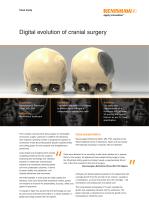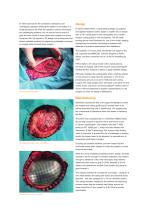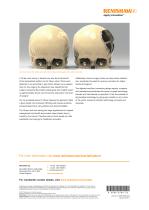
Catalog excerpts

Case study Customer: Neurosurgeon Bartolome Oliver, MD, PhD Challenge: The patient required a craniectomy to remove the growth and a cranioplasty to rebuild their skull. Solution: The parts were manufactured on a Renishaw AM250 metal 3D printing machine in titanium as per Dr Oliver's specification. Parts were delivered to us according to plan which allowed us to prepare them for the surgery. No adjustment was needed during surgery. Using the 3D-printed cutting guide and implant saved us approximately 30 per cent of the time required for this kind of surgery. Neurosurgeon Bartolome Oliver, MD, PhD (Spain) From complex reconstructive facial surgery to orthopaedic and trauma surgery, advances in additive manufacturing have inspired a growing number of progressive surgeons to commission metal 3D printed patient specific implants (PSIs) and cutting guides for both complex and straightforward procedures. Case studies are emerging which provide compelling evidence that the surgeons embracing this technology over standard implants or traditionally manufactured implants are consistently delivering better and more predictable outcomes, in terms of patient safety and satisfaction, and hospital efficiencies and economies. UK NHS hospitals, in their quest for better quality and efficiency, have used 3D-printed anatomical models, guides and implants to improve the predictability, accuracy, safety and speed of operations. A hospital in Spain has proved that the technology can also be used across international borders in a classic example of global technology transfer with UK experts. Case presentation Neurosurgeon Bartolome Oliver, MD, PhD, practises at the Teknon Medical Center in Barcelona, Spain and has trained internationally including in Canada, USA and Sweden. A 68-year-old female patient presented to his department with a benign growth from the left side of her cranium, caused by a meningioma, a tumour that arises from the meninges - the membranes surrounding brain and spinal cord. The computerised tomography (CT) scan revealed the growth was expanding outwards into the skull-bone. The patient required a craniectomy to remove the growth and a cranioplasty to rebuild her skull.
Open the catalog to page 1
Dr Oliver planned for the combined craniectomy and cranioplasty operation allowing the patient to be treated in a single procedure. He knew the operation should not present any challenging problems, but his priority was to ensure it gave the best results to both patient and hospital. He chose to partner with UK experts in 3D design and printing who had shown repeated evidence of supporting predictable outcomes in complex facial reconstructive surgery. Design Dr Oliver briefed PDR, a world-leading design consultancy and applied research centre, based in Cardiff, UK, to design both a PSI...
Open the catalog to page 2
Operation Dr Oliver had specified that a “pan-handle” be designed into the cutting guide to help position it during the craniectomy, aiding stability and improving the ergonomic performance of the device. An arrow was added onto the guide to indicate the orientation. The decision was taken to use the cutting guide to mark the perimeter of the craniectomy. Dr Oliver executed a freehand incision following the markings, after the guide was removed. This approach enabled an easier way to handle the complex skull geometry around the temporal area which curved to a tight radius. With additional...
Open the catalog to page 3
Left skull shows the defect and right skull shows cutting guide after defect removed A 30 per cent saving in theatre time was the third benefit of this streamlined method. As Dr Oliver noted, “Parts were delivered to us according to plan which allowed us to prepare them for the surgery. No adjustment was needed during surgery. Using the 3D-printed cutting guide and implant saved us approximately 30 per cent of the time required for this kind of surgery.” For his worldwide peers Dr Oliver believes his approach offers a good model. He comments,“Working with precise products and good planning...
Open the catalog to page 4All Renishaw catalogs and technical brochures
-
LaserImplant™
1 Pages
-
inVia™ confocal Raman microscope
28 Pages
-
WiRE™ software
8 Pages
-
M6 CMM clamping kit
2 Pages
-
Renishaw CMM fixtures
36 Pages
-
Mission to Nepal
4 Pages
-
3D modelling and printing
4 Pages
-
LaserAbutments™
4 Pages
-
DS10 system specifications
2 Pages
-
neuromate® stereotactic robot
17 Pages
-
Brochure neuromate
16 Pages
-
Brochure : Delivering precision
16 Pages
-
Neuroguide leaflet
2 Pages






















